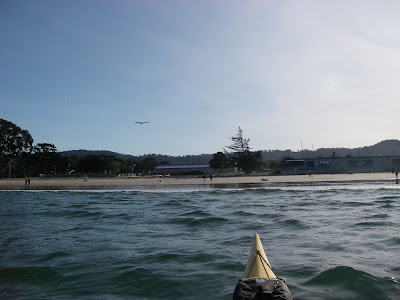While I was on a recent paddle down the coast several folks were wondering as to the height of the swell. The prediction for the day was 4-5ft at 10 seconds, or there about. Of course everyone attempts to estimate swell and wind wave size while they're out there. Usually, not always but usually, people are wildly off in their estimates.
When I was doing a BCU 3* assessment a couple years ago we were at the further edge of conditions that we could have been assessed in and the coaches asked everyone how big the waves we had just been in were. 2 to 3 foot was the common response. It was actually like 1 to 1.5 feet. On the trip down the coast some folks were throwing out numbers like 8 feet, as big as a house, and stuff like that. There was talk about the swell being influenced by the bottom and so jacking up a bit.Anyway, despite the fact that there are approximately 1.83 million web pages that talk about wave dynamics, I figured I'd take a few minutes and come at the subject from the perspective of a sea paddler. Fair warning, there is some math ahead.
There's a book called Waves and Beaches by Willard Bascom. Even though it's quite old (mine is from 1964) there is a huge amount of profoundly useful information in it. One subject it discusses is when a wave is influenced by the bottom. Waves that are influenced by the bottom are called shallow water waves. Shallow water waves are defined those that moving through water that has a depth of:
\begin{equation}.5 L\end{equation}
where L is the wavelength of the wave. The wavelength of the wave can be approximated by
\begin{equation}\frac{g}{2\pi}T^2 = 5.12\times T^2\end{equation}
where T is the period of the wave. Note please this formula is for a perfect sine wave. There are far more accurate formulas that take into account the height of the wave and so forth. But I think for this discussion the approximation is sufficiently accurate.
I didn't actually measure it while I was out there, but the prediction was for a period of 10 seconds. If we plug that in to the equation above we get
\begin{equation}5.12\times10^2=5.12\times100=512\end{equation}
From the definition of a shallow wave water above we get
\begin{equation}.5\times512=256\end{equation}
So if we were in less than 256 feet of water then the wave would be influenced by the bottom and, in fact, we were in far less than 256 feet of water. Absent this fact then we would have a deep water wave which could not have real cause, generally, to deviate far from the predicted values. Which get's us to the real heart of the matter.
We now have to calculate what I'll call the jack up factor. The jack up factor is basically the factor one can apply to the predicted swell height so as to arrive at the swell height at a specific location. There are actually 2 components to the jack up factor. The first is the HS component.
The HS component ranges from 0 to 2 with a nominal value of 1. The value for the HS factor is proportional to the degree of surprise one felt when the swell jacked up. Typically, though not always, the value of HS is directly proportional to the volume of the exclamation "holy shit" that frequently accompanies someone turning around and seeing an unexpectedly large wave behind them. Note that it is not the wording of the exclamation (e.g. "oh boy", "oh no", "lookit that" are all acceptable) but the volume that is significant here. One thing that can influence the value of HS is the audience to which the swell height estimate is being presented. For example an audience of well experienced paddlers that one wishes to impress might cause one to reasonably reduce the value of HS substantially.
The next component of the jack up factor is the BS component. The BS component ranges has a range from 1-5 with a nominal value of 5. The specific value of the BS component is influenced by many things. The naïveté of the audience of the estimate has a large influence on the value as can, for male estimators, the maximum attractiveness of the set of females present in the audience of the estimate. It is also the case that the BS component value is inversely proportional to the estimators self esteem.
Given all of this we can see then that given the prediction of 4-5 feet at 10 seconds in the depth of water we were in fact in (47 feet or so) there is basis for a reasonable estimate of swell height outside of the rather boring prediction of expert agencies and their frequently mis-calibrated buoys. Specifically we can say that the swell ranged from
\begin{equation}[4\times HS\times BS, 5\times HS\times BS]
=
[4\times 0 \times 1, 5\times 2 \times 5]
=
[0, 50]
\end{equation}
That is, the swell was from 0 to 50 feet that day at a specific place along the route taken.
Swell estimation, as I think has been made clear, is not easy. One cannot rely on data from buoys that were located, in many cases, miles away from where one actually experienced the swells to be estimated. Rather it is the application of scientific formulas, as above, that provides the basis for understanding and, far more importantly, the describing of the conditions one paddles in.
I hope this brief treatment of such a complex subject proves useful for both those who estimate swell height and for those who must consider the accuracy of swell height descriptions one may be subject to at the bar following a paddle.










